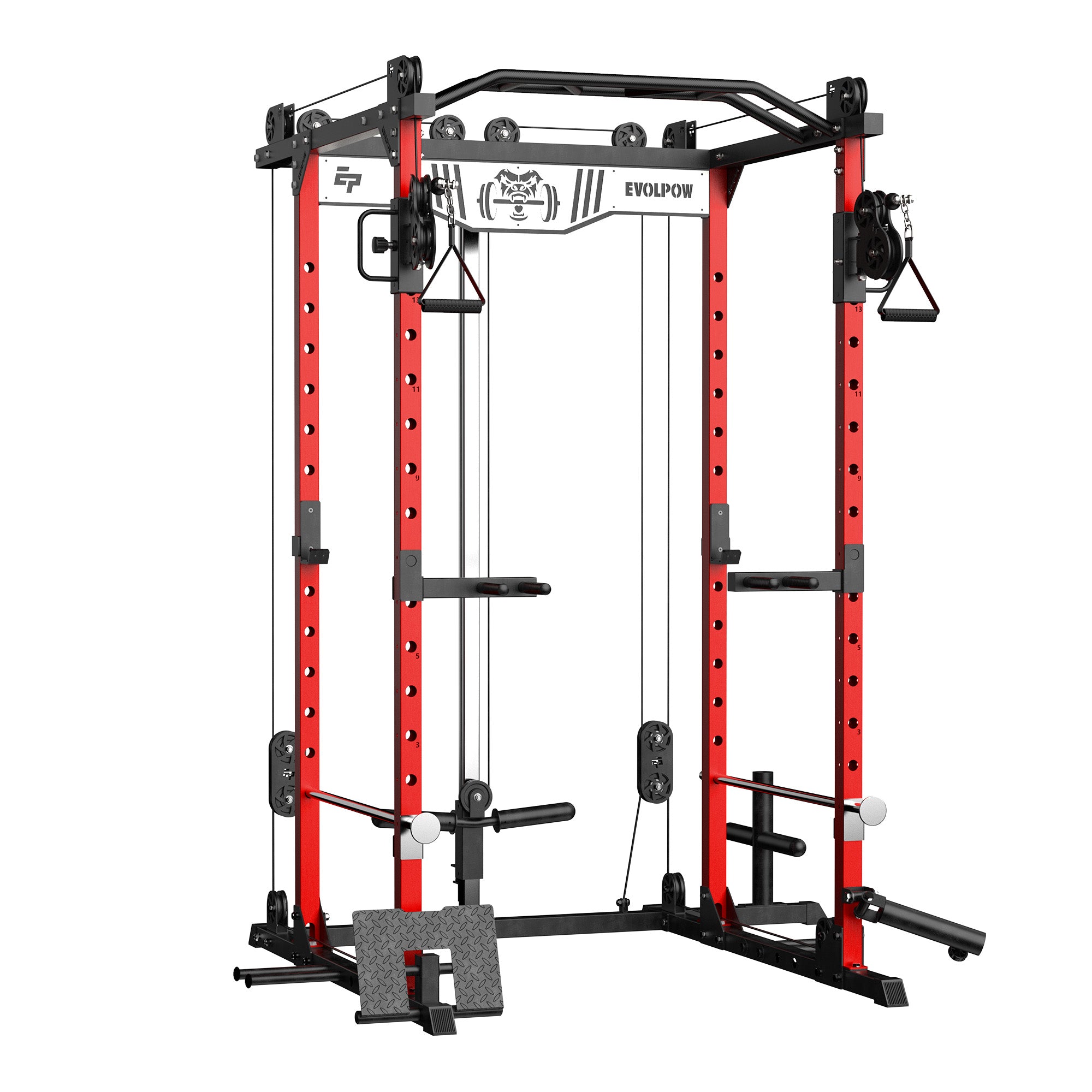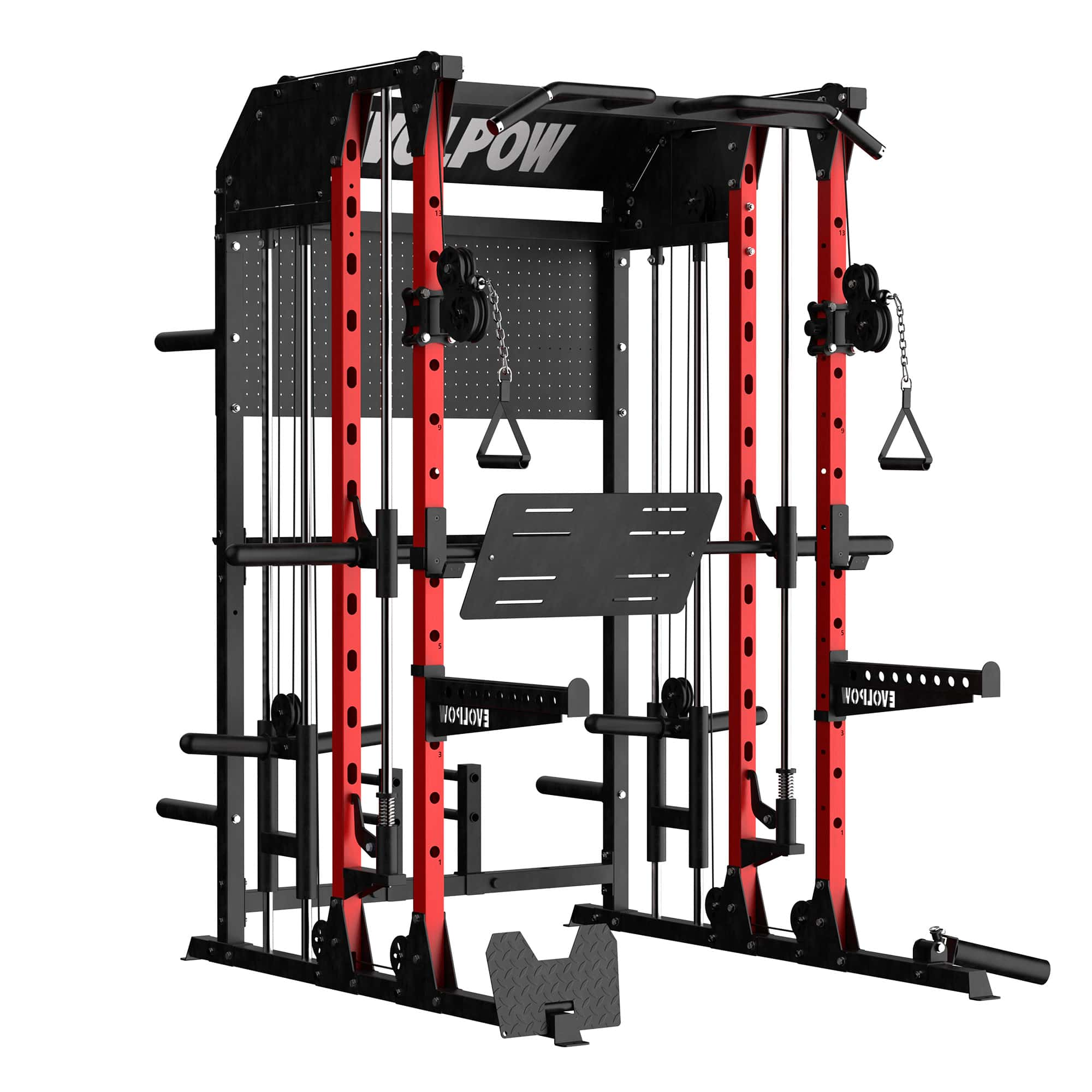The Smith Machine is a widely favored piece of equipment in both commercial gyms and home gym setups. Seen as second only to the power rack, it has inspired a variety of innovative and effective exercises. But why use a Smith Machine in the first place? From a training perspective, it's fixed bar path provides stability and helps guide your movements, making it easier to isolate target muscles and enhance mind-muscle connection. This not only benefits bodybuilders focusing on isolation work but also helps beginners quickly improve technique and muscle control.
CONTENT
Understanding the Smith Machine
How to Use a Smith Machine Effectively
Tips for Beginners
Understanding the Smith Machine
To understand the Smith Machine, we first need to explore the fundamental differences between it and the traditional free weight training rack—the power rack. In daily training, the primary function of a power rack isn’t necessarily for exercise itself, but for safety. It supports the barbell to make lifting off easier and, more importantly, features safety bars to catch the weight if the user fails mid-movement. This ensures that the trainee can train with confidence and minimal risk.
For example, the Evolpow P2A power rack is a classic, no-pulley power rack that reflects the essence of traditional strength training setups. Now, imagine training without a rack—say you’re doing an overhead press. Without any support, you’d have to lift the barbell from the floor like an Olympic lifter. If you lose control, you’d need space to drop the bar safely. Not only is that highly impractical for a home gym, but even in commercial gyms, this kind of movement is often forbidden due to safety concerns for both users and the facility.

Once we understand the role of the power rack, it becomes easier to understand the structure and mechanics of the Smith Machine. Think of it as a barbell fixed to a training rack, which moves vertically or along a set path. It typically includes two main safety mechanisms: one to catch the bar if you fail during a rep, and another that allows you to easily rack and unrack the bar. This design can be seen clearly in models like the Evolpow M2D Smith Machine.

The safety of the Smith Machine isn’t just in the hardware—it’s also in the way it guides the movement. By fixing the barbell’s path, it helps beginners avoid poor form and unnecessary muscle compensation, which often reduces training efficiency. Without proper technique, a new lifter may also lose core balance, increasing the risk of injury when using free weights.
That’s why the Smith Machine is such an effective and beginner-friendly piece of equipment. It allows users to focus on muscle engagement and proper movement patterns without the need to stabilize the bar in multiple directions, offering both safety and support throughout the learning process.
How to Use a Smith Machine Effectively
To use the Smith Machine correctly, it's important to understand that in most designs, the force direction aligns with the track, meaning the resistance is directly vertical. Therefore, to move efficiently, your movement path should stay parallel to the direction of resistance. When that alignment is achieved, the movement becomes stable and effective.
Since the Smith Machine essentially fixes a barbell onto a vertical track, it theoretically allows users to perform most of the same exercises as a traditional power rack—but with more guidance and safety. Let’s break down how to use the Smith Machine properly through four common compound movements: squats, flat bench press, shoulder press, and bent-over rows. All demonstrations will refer to the Evolpow M2D Smith Machine.
Smith Machine Squat
The squat is a compound movement that targets nearly every major muscle group in the lower body, while also requiring the upper body to stabilize heavy loads. However, for beginners who may not have full control over multiple muscle groups at once, the Smith Machine offers a safer and more manageable way to learn.
Start by adjusting the bar to the appropriate height for your starting position. Then, set the lower safety catches to the point where the bar just touches them at the bottom of your squat—this prevents injury in case of failure. You can use a shoulder pad for comfort and position the bar across your upper traps. Your heels should align directly under the bar. As you squat down, move slowly and focus on engaging your legs. On the way up, drive with power and return to a standing position.

Smith Machine Flat Bench Press
The flat bench press primarily targets the pectoral muscles. For safe training, begin by setting safety stops at the bar's lowest point of descent. Next, set the bar height to your starting position. Position your bench directly under the Smith Machine so that when you lie back, the bar lines up with the middle of your chest.
Grip the bar fully with a width slightly wider than shoulder-width. From a side view, your forearms should remain nearly parallel to the machine’s rails. This ensures the direction of your pushing force directly opposes the vertical resistance, giving you an effective and safe chest workout.

Smith Machine Shoulder Press
The shoulder press targets the anterior deltoids and some of the lateral delts. A traditional standing press requires core stability to press a barbell overhead. The Smith Machine version mimics this movement but emphasizes isolation of the shoulder muscles.
Begin by adjusting your bench to an upright 90-degree angle and placing it under the bar. Adjust the bar so it rests just in front of your upper chest when seated. Position the safety catches carefully, set the lower one just below the level where your upper arms are parallel to the ground, and the upper catch at a point where your arms are slightly bent at the top. This setup allows you to perform a strict shoulder press with better control and reduced injury risk.
Smith Machine Bent-Over Row
The Smith Machine row is a standing, bent-over exercise that doesn’t require a bench. Stand with your feet under the bar and hinge at the hips until your torso is nearly parallel to the floor. Then, contract your back muscles to pull the bar up toward your lower abdomen.
For beginners, it’s recommended to raise the bar slightly by setting the lower safety stops just below knee height. This shortens the range of motion slightly and helps prevent lower back compensation, allowing better focus on isolating the back muscles and improving muscle activation.

Tips for Beginners
Through the breakdown of these four common exercises, it's clear that proper Smith Machine training relies on aligning your force output directly against gravity. The more your movement stays parallel to the machine’s guided track, the easier it becomes to maintain the correct motion path. Over time, this helps beginners build muscle memory, laying a solid foundation for transitioning to free weight training in the future.
While the Smith Machine is a safe and reliable piece of equipment, improper angles or lack of warm-up can still lead to injury. That’s why it’s crucial to maintain a proper warm-up routine before training. Start by adjusting the Smith bar and safety catches to the correct height, then perform a few warm-up sets using only the bar. This helps you find your ideal stance, grip width, and body position.
During your warm-up, take a moment to think about which muscle groups you're targeting and what angle will allow your force to align properly with the machine’s track. Finally, brace your core, use supportive gear if needed, and stay focused throughout your workout.
CONCLUSION
Overall, the Smith Machine is an excellent foundational tool for beginners. Its guided path allows for controlled, isolated muscle training, helping users become familiar with proper movement patterns and develop a better mind-muscle connection. Thanks to the fixed track and dual safety catch design, the risk of injury is also significantly reduced.
Incorporating the Smith Machine into your regular training routine is a smart and safe choice. It not only helps beginners ease into strength training with confidence but also allows more advanced lifters to fine-tune muscle definition and enhance muscle pump. Whether you’re just starting or looking to elevate your training, the Smith Machine can be a valuable asset in your fitness journey.
FAQ
Q: Is a Smith machine good for beginners?
A: Yes. The Smith Machine is an ideal choice for beginners due to its high safety and stability. Its fixed track helps users maintain proper form, isolate target muscles more easily, and build confidence while learning fundamental movement patterns.
Q: Can you still build muscle with a Smith machine?
A: Absolutely. The Smith Machine allows for controlled movements, making it easier to handle heavier loads safely. Its stability also makes it ideal for isolation exercises, helping to target specific muscles and refine muscle definition. That’s why both beginners and bodybuilders often include the Smith Machine in their routines—it supports both size and detail.
Q: What is the right way to use a Smith machine?
A: Start by understanding your training goal and the basic mechanics of the Smith Machine. Since the bar moves along a fixed vertical track, it's important to align your force output in the opposite direction of the resistance—essentially, straight up against gravity. By keeping your movement path parallel to the machine’s track, you can perform exercises more efficiently and safely.
REFERENCE
https://www.youtube.com/watch?v=j1rytttNJa0&t=131s
https://www.youtube.com/watch?v=cUYFaO6XDBQ
https://www.womenshealthmag.com/fitness/a63572763/how-to-use-a-smith-machine/
https://www.youtube.com/watch?v=YT-lgVKPaWw&t=4s






